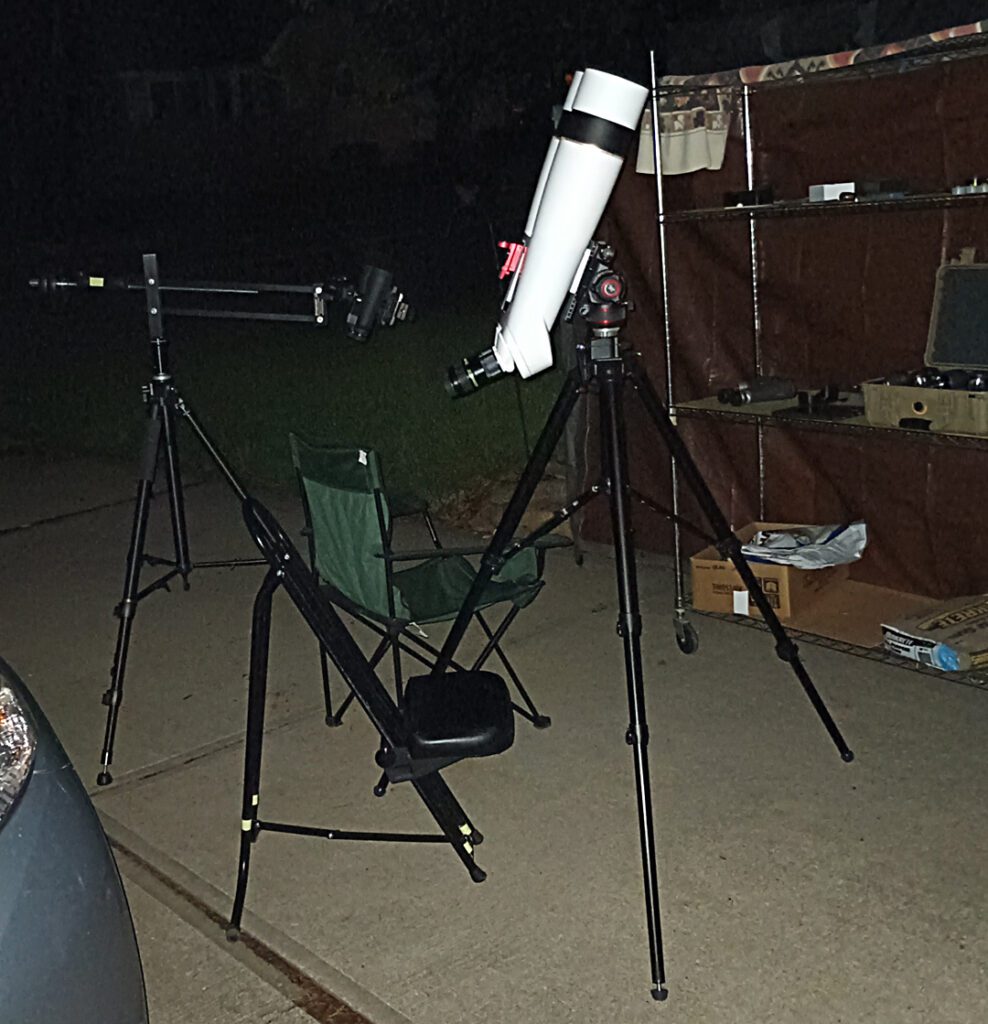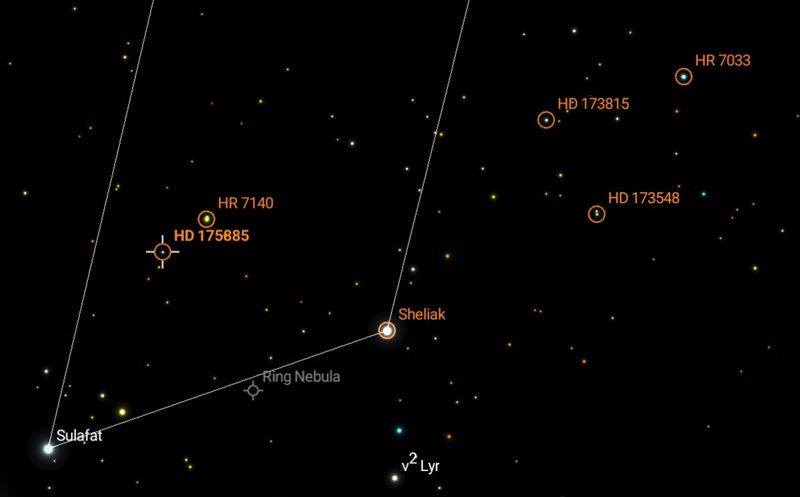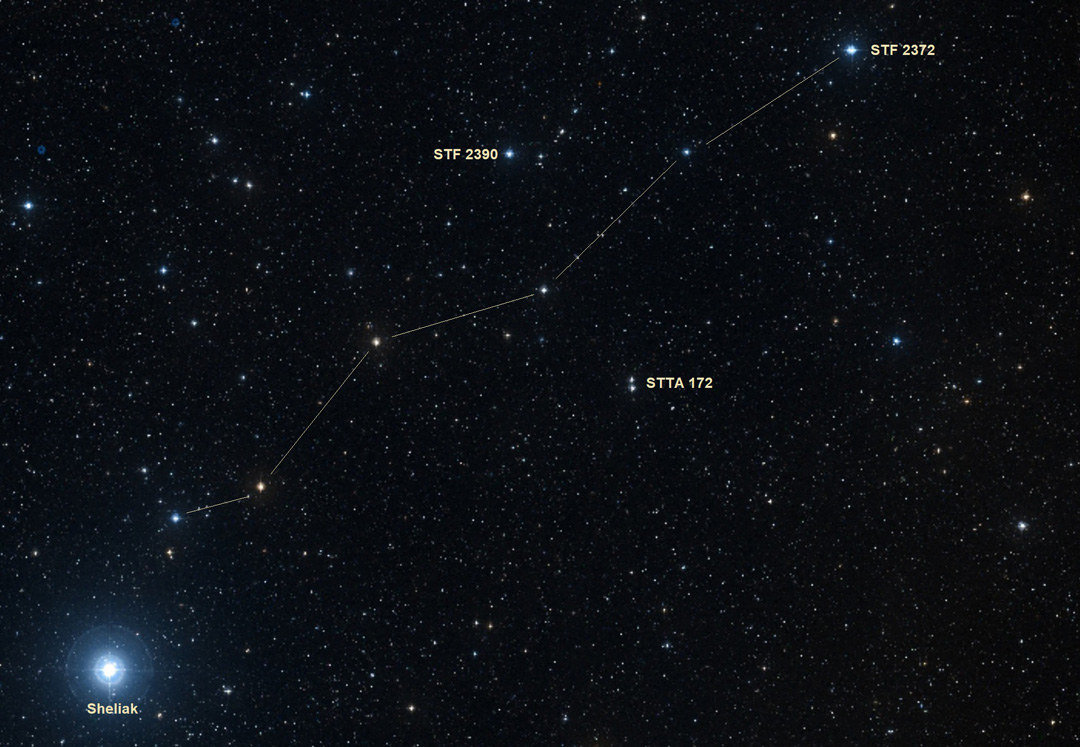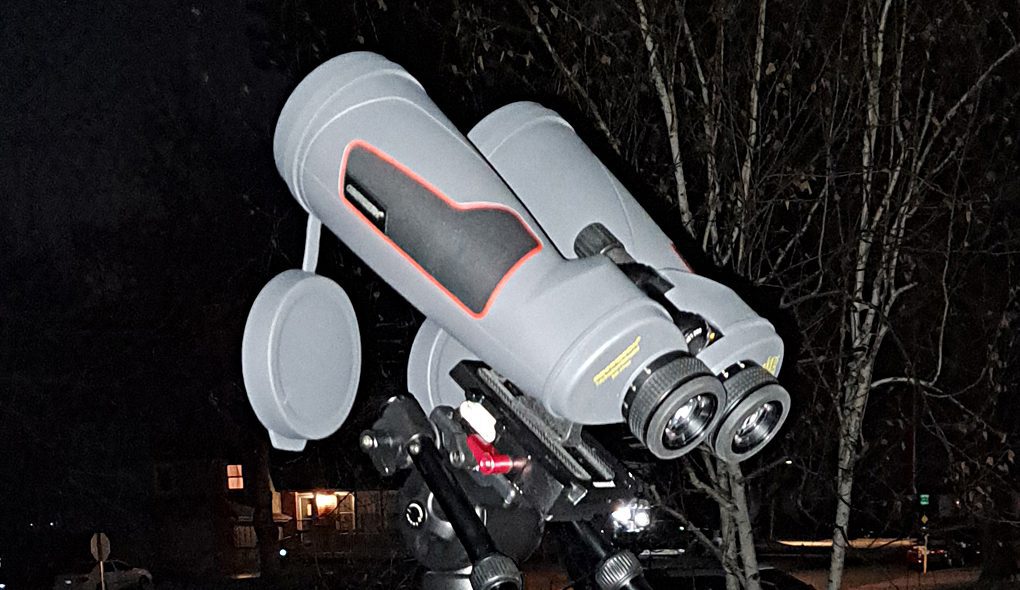Over the past several years my observing has centered around viewing double stars with binoculars, which is not a common practice among astronomy hobbyists. Telescopes are widely preferred for these objects. The classic image is an observer with a refractor resolving close (hopefully sub-arc second) doubles. Binoculars are thought to be suitable only for extremely wide and bright pairs based on the expectation of hand held use. But that limitation does not apply to mounted binoculars. Even modest instruments in the 10-20x range are capable of resolving thousands of doubles once mounted. The closest double star I have resolved with a 10x binocular (100 Herculis) has a separation of 14 arc-seconds, which is wide by telescopic standards but far closer than is commonly believed resolvable at such low magnification. Doubles under 10 arc-seconds can be resolved with 20x binoculars.
If telescopes are preferred by so many, why choose binoculars instead?
From early in my astronomy adventures, which commenced in earnest in 1999 when I was in my 30s, I have enjoyed double stars. I completed the Astronomical League Double Star program (which includes 100 popular double stars) in 2002, creating a 3-ring binder with sketches and observing notes for all one hundred objects. To this day, one of my favorite observing projects. I enjoy observing a variety of deep sky objects, not only doubles. But a few faint fuzzies on the evening program is enough for me. I have heard it said that globulars are boring, many having a similar appearance, but they aren’t to me. Galaxies, on the other hand, become tedious for me. If the site you are observing from is reasonably dark, and you have a moderately large telescope, the number of galaxies that can be seen is astronomical. 😏 Many, many thousands. Most of which are vague bits of shapeless nebulosity just detectable in averted vision. I’m happy to leave those to the astro-imagers.
To be sure, the closest double stars, say under 4 seconds, can be a challenge to resolve, and sub arc-second doubles require outstanding skies, instruments, and visual acuity. To me, struggling to resolve extremely close doubles is similar to struggling to view faint galaxies. I guess I’m just lazy and for the most part prefer objects that are easily seen. For whatever reason, however, I am more impressed by feats of double star resolution than faint galaxy detection.
But many double stars are easy to see, and no two are precisely alike, varying in magnitude, color, separation, position angle, number of components, and starfield location. A lot of variety and anything but boring and tedious.

More importantly, most of my observing is done from my urban yard, which is in a white light pollution zone, having a limiting naked eye magnitude of around 4.5 near the zenith on the best nights. Close to what might be categorized as Bortle 8 skies, where a SQM-L reading of 18.20 MPSAS (magnitudes per square arc-second) is darn good. The best observing sites have readings under 21.0 MPSAS, which is extremely dark compared to my yard. With so much light pollution, galaxies and other faint extended objects are a lost cause. Except for a handful of the brightest, they cannot be seen visually even with large telescopes. But stars are less affected by light pollution. Much less. So stellar objects like double stars, carbon stars, variable stars, open clusters, asterisms, and star fields are readily viewed in light polluted skies with binoculars and binocular telescopes. Include a mix of brighter globular clusters, planetary and emission nebulae, a few galaxies, and lunar observing and planets with this, and one has observing projects to last a lifetime. Without leaving home.
I enjoy dark sky site visits, but those are a fraction of my total observing time. Any evening the skies are clear I can step outside for a few minutes of quick observing, which often enough turns into a few hours. Regardless of my schedule. If the sky conditions are iffy, there is no need to risk hours of time loading/unloading my vehicle and driving at least 30 minutes each way to reach a reasonably dark observing location. It is a 2-3 hour time commitment apart from observing. Easily. Versus glancing outside and if the sky is clear carrying out a tripod and binocular. Plus all the comforts and conveniences of home. How hard is the math?
Observing with mounted binoculars is easier than observing with telescopes, despite misguided objections about the “inconvenience” of mounted binoculars. Compared with hand held? Okay. But compared with a telescope? That’s a joke. Binoculars on light tripods or parallelogram mounts, or binocular telescopes (with 45-degree prisms) on tripods can be carried outside in a minute. Finding one’s way around the sky with binoculars, using both eyes, with wide fields of view and correct images (not mirror reversed or upside down) is natural and intuitive. It’s like looking out the window of a space ship. So much easier than navigating with a telescope there is no comparison. The considerable difficulty of getting a telescope pointed at an object is why go-to telescopes are sold, to say nothing of the setup time.
After decades of star-hopping I did purchase a GoTo mount – an iOptron AZ Pro on a Tri-pier – ironically, for use with a large binocular telescope – an Oberwerk 127XL-SD.
But there is something more here. Even for proficient telescopic observers – and I include myself in that number – most of one’s time is spent looking at tiny bits of the sky. Navigating from one deep sky object (DSO) to the next as quickly as possible, treating stars as connect the dot patterns (aka star-hopping) solely to get the next object in view, missing the astonishing beauty of star fields or any real sense of the entire sky, or how constellations fit together and where objects are in relationship to starfields or to each other. It’s not holistic. It’s looking at the sky wearing blinders. It’s small picture, not big picture. It’s not seeing the sky for the faint fuzzies.
For me binocular double stars are just the opposite. One is viewing star fields to a considerable extent, even when seeking particular double stars. And viewing double stars in a larger context of the star fields and distinctive asterisms in which they are found. And there are so many doubles, so easily seen even in light polluted skies, one frequently encounters unexpected doubles, which are then fun to identify and add to observing routines.
Here is a recent observing experience that captures what to me is the essence and profound appeal of binocular double star observation.

I enjoyed a fine view of the Ring Nebula in Lyra (M 57) with the Oberwerk 120XL-SD and Pentax 20mm XW eyepieces (33.5x / 2.09* FOV). In the normal hobby astronomy mode, the next object up is often M 56, a globular cluster also in Lyra. But what else might be seen near M 57? 😉
Here is a Sky Safari chart highlighting multiple double stars near the Ring Nebula.

I began with the two doubles north of the Ring Nebula (above it in the chart).
STT 525 / HR 7140
18h54m +33*58′
AC 6.14/7.60 sep 45.4″ pa 350*
Physical double star
Distance: 1482.13 LY
Spectral Type: G5III+A8 / A E
Color Index: +0.93 yellow-orange / -0.06 blue-white
Yellow primary with blue secondary. Generously spaced. A fine bright pair. Obvious magnitude difference.
STF 2421 / HD 175885
18h56m +33*47′
8.13/9.34 sep 24.6″ pa 57*
Optical double star
Distance: 1180.40 LY
Spectral Type: B9V D / ??
Color Index: -0.04 blue-white / +0.49 yellow-white
Quite near STT 525 but the secondary is faint so it is easy to overlook and sweep past. Have I noticed this double before? Brilliant white primary with a tan secondary, close but not tight. Nikon 18×70.
Here is an image from SIMBAD of Sheliak and the three doubles to the northwest (upper right in the Sky Safari chart).

STFA 39 / Sheliak
18h50m +33*22′
3.63/6.69 sep 45.7″ pa 149*
Distance: 960 LY
Spectral type: B8.5Ib-II C / B7V C
Color Index: +0.00 white / -0.08 blue-white
Glorious with the 120XL+20XWs Brilliant light yellow primary with a diminutive neon blue secondary at a comfortable distance. A sprinkling of faint stars hovering about – maybe also part of the system? Colors readily seen with Nikon 18×70 IF WF.
STF 2372
18h42m +34*45′
6.45/7.73 sep 25″ pa 82*
Optical double star
Distance: 1489 light years
Spectral type: B5V / A0
Color Index: -0.11 blue-white / -0.05 blue-white
A cozy pair of bright white and pale blue stars. A fine double at the end of a stream of stars leading away from Sheliak. Midway along the stream, on either side, are two additional doubles.
STTA 172
18h44m +34*00′
7.91/8.66 sep 64.9″ pa 5*
Physical double star
Distance: 178.5 light years
Spectral type: F8 / F8
Color index: +0.50 yellow / +0.65 yellow
Warm white primary with sand colored secondary, generously spaced.
STF 2390
18h45m +34*31′
7.37/8.56 4.3″ pa 155*
Nature uncertain
Distance: 1164.99 light years
Spectral type: A5 / ??
Color Index: +0.21 yellow-white / ??
Could see it as two stars in contact at 33.5x with the 20XWs. Needed the 10 XWs (67x) to resolve. Challenging even at 67x. Too close to get colors.
The Ring Nebula is a fun object to observe, and something I have viewed many many times over the years. But this is the first time I studied the starfield around it with any care. And what I found is delightful. Honestly, as pleasing as any deep sky observing I have done. A group of fine double stars exhibiting typical variety, including a challenging closer double. The star stream leading from Sheliak to STF 2372, with attendant doubles on either side is something I will return to with pleasure and enjoyment. And learn more on each visit – the spectral types of the brighter stars, their distances, etc. All from my own yard. This is the essence of binocular astronomy to me.


Another excellent blog, Fiske. We suburban binocular astronomers have much to enjoy from our backyards.
Yes we do! 😁
I have started a project to compile a Bortle 7 Binocular 400 list, featuring 400 objects including double stars, carbon stars, variable stars, asterisms, open clusters, star fields, and brighter globular clusters, nebula, and galaxies that can be observed with 15x (or larger) binoculars in suburban skies. Many of the objects will be observable with 10x binoculars. Blog posts about it will be forthcoming.
Thanks for your comment, TJ.
Lyra is my current hot topic and I didn’t realize it had so many doubles until now! Certainly plenty more to study, I tried to pick out M57 last night, as our light pollution looks very similar what would you advise magnification wise on the BT70 to pick out M56/M57 and some doubles?
Anything in the 28 to 40x range would be fine (that’s like 14mm to 10mm). Honestly, it can be seen as non-stellar at 20x and even 15x on a good night, but a bit more magnification makes it an obviously non-stellar disk, which is really fun. I never get tired of peeking at it on my rambles through Lyra. 😊 (It’s kind of a fun 10x challenge, just to be able to see something there, which takes a good night in urban skies. And, needless to say, a mounted binocular.)